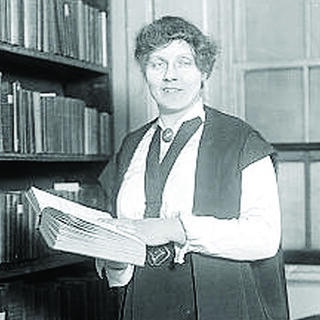She was a passionate believer in social reform, a pioneer in the legal profession and a champion of women’s rights to rival Emmeline Pankhurst. But for Edge Hill graduate Helena Normanton, there is no statue in London or picture in the National Portrait Gallery to celebrate her achievements.
So, why is this remarkable woman so overlooked in women’s history? Alumni Magazine spoke to Judith Bourne, who is writing her PhD on Normanton, to find out.
“The sad truth is that very little is known about her,” says Judith, barrister and Senior Lecturer in Law at London Metropolitan University. “I teach a course on women and law and even I only came across her by accident.
“The fact that her achievements have been so neglected in the past is a real tragedy as, for me, she is up there with the Pankhursts and Rose Heilbron in terms of her contribution to women’s history.”
Helena Normanton was the first woman to practise at the English Bar in 1922, the first female barrister to lead the prosecution in a murder trial, to conduct a trial in America, and to represent cases in both the High Court and the Old Bailey. She was also one of the first two women, along with Rose Heilbron, to become Kings Council, the highest qualification awarded to a barrister.
She scandalised the legal profession, first by wanting to be part of it, then by insisting on practising in her maiden name. A prolific campaigner for equality within marriage, Normanton was the first married woman in the UK to be issued a passport in her maiden name. Speaking about Anne Boleyn, she once quipped, “she may have lost her head, but at least she was allowed to keep her name!”
“It was very difficult for her because a lot of people wanted her to fail,” says Judith. “She faced discrimination from within the legal profession; many male solicitors refused to brief a female barrister, and she was the subject of vitriolic hate mail, some, seemingly, from other women in the profession.
“Helena was also accused of advertising her services, which was illegal and could have seen her debarred. She demanded a full enquiry and, although she was completely exonerated, she never became as successful a lawyer as she should have been and had to supplement her income by writing and renting out rooms in her house.”
Very little is known about Normanton’s life before her legal career. She is known to have been a trainee teacher at Edge Hill, graduating in 1905, but how or why she came to be studying so far from her home town of Brighton is a mystery.
“I’m really looking forward to exploring the Edge Hill connection,” says Judith. “Edge Hill was known to be a hotbed of early feminist thinking and had connections to the Suffragette movement. We don’t know whether she was radical before she went to college or was radicalised by her experiences and the people she met there. It will be interesting to try and find out.”
Helena Normanton epitomises the spirit and ethos of Edge Hill that still exists to this day. The child of a working class single parent, with no family history of participation in higher education, Helena still managed to rise above her circumstances and succeed, thanks, in part, to her education at Edge Hill.
The causes that she fought for – social justice, equal pay, women’s rights – are still important to Edge Hill and form the basis of some of the cutting edge research undertaken by staff at the institution today.

